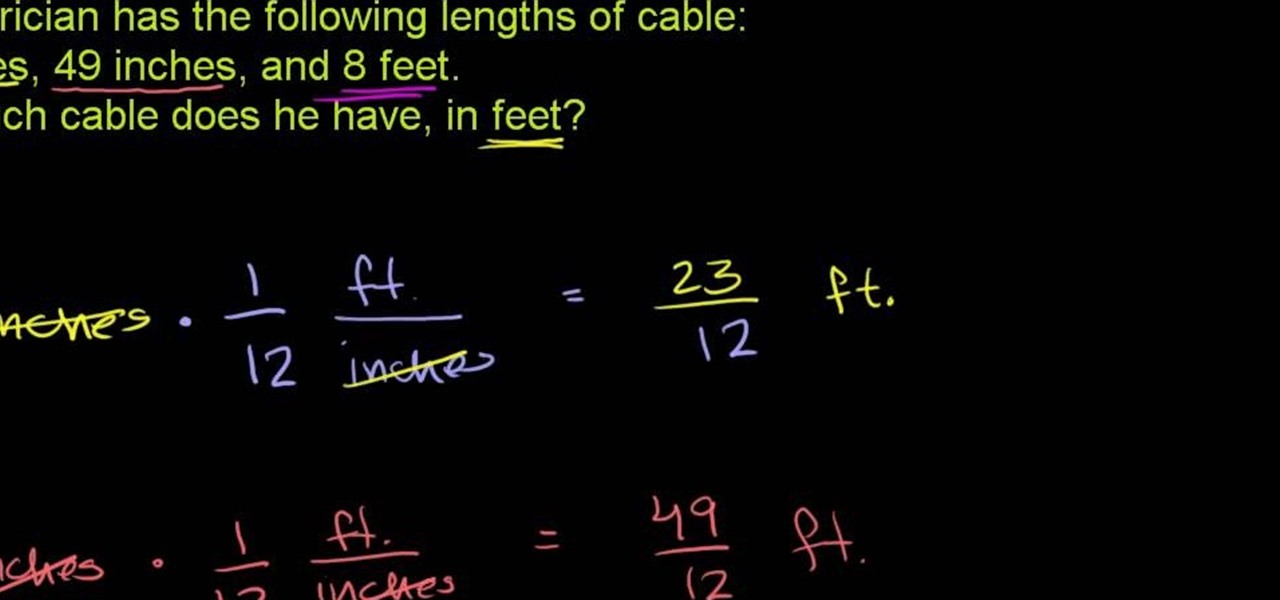Hot Education Posts


How To: Determine whether you child is performing at grade level in math
Math is arguably the most important subject your children study in school, and making sure they're keeping up is important. If you want to determine whether you child is performing up to their grade level, watch this video. It will give you ideas for ways to test whether that is the case.

News: Cheeseburger Dipped in Acid (Plus: Why You Should Fear McDonald's)
Ok, so first Periodic Tables demonstrates how a McDonald's cheeseburger breaks down in your stomach during the digestion process. Everybody has hydrochloric acid in their stomach, so drop a burger in acid and you can see it happen before your eyes (minus the amino acids a human stomach would supply). Seems innocent enough. Here's what happened after 3.5 hours: NASTY. So my question is: does healthy food look the same? What would a pile of broccoli or granola look like? Probably just as nasty....

News: Super Slo-Mo Lightning Looks Like Mother Earth's Fireworks Show
Mother Earth, God, Buddha, the Universe, energy fields... whatever you call it, lightning slo-mo'ed looks like some higher being set off some major fireworks. Beautiful. Two videos in the gallery below.

How To: Understand Ohm's Law
This video teaches the basics of Ohm's law, which is an important equation in electrical engineering. The three variables which are used in this equation are V, which stands for voltage, I for current, and R for resistance. The equation for the law itself is I=V/R. This law defines the relationship between these three very important electrical properties. The host of the video further explains what voltage, current, and resistance are and how they work in relation to an electrical current. Gi...

How To: Find how many toothpicks will be needed to form the nth figure in a sequence
From Ramanujan to calculus co-creator Gottfried Leibniz, many of the world's best and brightest mathematical minds have belonged to autodidacts. And, thanks to the Internet, it's easier than ever to follow in their footsteps. With this installment from Internet pedagogical superstar Salman Khan's series of free math tutorials, you'll learn how to employ inductive reasoning to determine the number of toothpicks you'll require to generate the nth (e.g., the 50th) figure in a sequence of figures.

How To: Prove that the areas of diagonal-generated triangles are equal in geometry
From Ramanujan to calculus co-creator Gottfried Leibniz, many of the world's best and brightest mathematical minds have belonged to autodidacts. And, thanks to the Internet, it's easier than ever to follow in their footsteps. With this installment from Internet pedagogical superstar Salman Khan's series of free math tutorials, you'll learn how to demonstrate that a diagonal line drawn from one corner of a rectangle to another will generate two equivalent triangles.

How To: Find the inverse of a function in intermediate algebra
From Ramanujan to calculus co-creator Gottfried Leibniz, many of the world's best and brightest mathematical minds have belonged to autodidacts. And, thanks to the Internet, it's easier than ever to follow in their footsteps. With this installment from Internet pedagogical superstar Salman Khan's series of free math tutorials, you'll learn how to solve problems involving function inverses.

How To: Representing a number as a decimal, percent, and fraction
From Ramanujan to calculus co-creator Gottfried Leibniz, many of the world's best and brightest mathematical minds have belonged to autodidacts. And, thanks to the Internet, it's easier than ever to follow in their footsteps. With this installment from Internet pedagogical superstar Salman Khan's series of free math tutorials, you'll learn how to express a number as a decimal, percent and/or fraction.

How To: Describe the meaning of percent in basic mathematics
From Ramanujan to calculus co-creator Gottfried Leibniz, many of the world's best and brightest mathematical minds have belonged to autodidacts. And, thanks to the Internet, it's easier than ever to follow in their footsteps. With this installment from Internet pedagogical superstar Salman Khan's series of free math tutorials, you'll learn how to explain what a percentage is within the context of basic arithmetic.

How To: Differentiate between Celsius and Fahrenheit temperature scales
In this free video science lesson from Internet pedagogical superstar Salman Khan, you'll learn how to differentiate between Celsius and Fahrenheit scales, identifying the freezing and boilings points of each. Whether you need help studying for that next big test or could just use a hand finishing your homework, you're sure to be well served by this video lesson. For more information, including detailed, step-by-step instructions, take a look.

How To: Solve SN1 & SN2 reaction problems that involve solvents in organic chemistry
In this free video science lesson from Internet pedagogical superstar Salman Khan, you'll learn how to undertstand the effects of solvents on SN1 and SN2 reactions. Whether you need help studying for that next big test or could just use a hand finishing your homework, you're sure to be well served by this video lesson. For more information, including detailed, step-by-step instructions, take a look.

How To: Visualize a cyclohexane molecule with chair & boat shapes in organic chemistry
In this free video science lesson from Internet pedagogical superstar Salman Khan, you'll learn how to represent and interpret cyclohexane molecules in organic chemistry. Whether you need help studying for that next big test or could just use a hand finishing your homework, you're sure to be well served by this video lesson. For more information, including detailed, step-by-step instructions, take a look.

How To: Work with stereoisomers, enantiomers and diastereomers in organic chemistry
In this free video science lesson from Internet pedagogical superstar Salman Khan, you'll learn how to work with stereoisomers, enantiomers, diastereomers, constitutional isomers and meso compounds in organic chemistry. Whether you need help studying for that next big test or could just use a hand finishing your homework, you're sure to be well served by this video lesson. For more information, including detailed, step-by-step instructions, take a look.

How To: Work with reaction mechanisms in organic chemistry
This free video science lesson from Internet pedagogical superstar Salman Khan presents a general introduction to the concept of reaction mechanisms in organic chemistry. Whether you need help studying for that next big test or could just use a hand finishing your homework, you're sure to be well served by this video lesson. For more information, including detailed, step-by-step instructions, take a look.

How To: Use Markovnikov's rule with carbocations in organic chemistry
In this free video science lesson from Internet pedagogical superstar Salman Khan, you'll learn how to apply Markovnikov's rule to solve carbocation problems in organic chemistry. Whether you need help studying for that next big ochem test or could just use a hand finishing your homework, you're sure to be well served by this video lesson. For more information, including detailed, step-by-step instructions, take a look.

How To: Deal with SN2 (biomolecular nucleophilic substitution) reactions in chemistry
In this free video science lesson from Internet pedagogical superstar Salman Khan, you'll learn how to understand and work with SN2 reactions in organic chemistry. Whether you need help studying for that next big test or could just use a hand finishing your homework, you're sure to be well served by this video lesson. For more information, including detailed, step-by-step instructions, take a look.

How To: Work with steric hindrance in organic chemistry
In this free video science lesson from Internet pedagogical superstar Salman Khan, you'll learn how to use Markovnikov's rule to understand steric hindrance in organic chemistry. Whether you need help studying for that next big test or could just use a hand finishing your homework, you're sure to be well served by this video lesson. For more information, including detailed, step-by-step instructions, take a look.

How To: Work with SN2 reactions in stereochemistry
In this free video science lesson from Internet pedagogical superstar Salman Khan, you'll learn how to handle SN2 substitution reactions in stereochemistry. Whether you need help studying for that next big test or could just use a hand finishing your homework, you're sure to be well served by this video lesson. For more information, including detailed, step-by-step instructions, take a look.

How To: Polymerize an alkenes with an acid in organic chemistry
In this free video science lesson from Internet pedagogical superstar Salman Khan, you'll learn how to handle the polymerization of an alkene with an acid in organic chemistry. Whether you need help studying for that next big test or could just use a hand finishing your homework, you're sure to be well served by this video lesson. For more information, including detailed, step-by-step instructions, take a look.

How To: Work with substitution or SN1 reactions in organic chemistry
In this free video science lesson from Internet pedagogical superstar Salman Khan, you'll learn how to handle SN1 reactions in organic chemistry. Whether you need help studying for that next big test or could just use a hand finishing your homework, you're sure to be well served by this video lesson. For more information, including detailed, step-by-step instructions, take a look.

How To: Work with reaction mechanisms in organic chemistry
In this free video science lesson from Internet pedagogical superstar Salman Khan, you'll learn how to handle reaction mechanisms in organic chemistry. Whether you need help studying for that next big test or could just use a hand finishing your homework, you're sure to be well served by this video lesson. For more information, including detailed, step-by-step instructions, take a look.

How To: Work with hybridized orbitals and sigma bonds in organic chemistry
In this free video science lesson from Internet pedagogical superstar Salman Khan, you'll learn what to do with hybridized orbitals and sigma bonds in organic chemistry. Whether you need help studying for that next big test or could just use a hand finishing your homework, you're sure to be well served by this video lesson. For more information, including detailed, step-by-step instructions, take a look.

How To: Represent chiral molecules in organic chemistry
In this free video science lesson from Internet pedagogical superstar Salman Khan, you'll learn how to visualize chiral molecules in organic chemistry. Whether you need help studying for that next big test or could just use a hand finishing your homework, you're sure to be well served by this video lesson. For more information, including detailed, step-by-step instructions, take a look.

How To: Create a double Newman diagram for methcyclohexane in organic chemistry
In this free video science lesson from Internet pedagogical superstar Salman Khan, you'll learn how to create a double Newman diagram for methcyclohexane. Whether you need help studying for that next big test or could just use a hand finishing your homework, you're sure to be well served by this video lesson. For more information, including detailed, step-by-step instructions, take a look.

How To: Use and read Newman projections in organic chemistry
In this free video science lesson from Internet pedagogical superstar Salman Khan, you'll learn how to create and interpret Newman projections in organic chemistry. Whether you need help studying for that next big test or could just use a hand finishing your homework, you're sure to be well served by this video lesson. For more information, including detailed, step-by-step instructions, take a look.

How To: Use Markovnikov's rule to determine the likelihood of an addition reaction
In this free video science lesson from Internet pedagogical superstar Salman Khan, you'll learn how to use Markovnikov's rule to figure out which addition reaction is most likely in organic chemistry. Whether you need help studying for that next big test or could just use a hand finishing your homework, you're sure to be well served by this video lesson. For more information, including detailed, step-by-step instructions, take a look.

How To: Represent the structure of a molecule in organic chemistry
Need some help figuring out how to represent an organic molecule? You're in luck: In this free video science lesson from Internet pedagogical superstar Salman Khan, you'll learn how to just that. Whether you need help studying for that next big test or could just use a hand finishing your homework, you're sure to be well served by this video lesson. For more information, including detailed, step-by-step instructions, take a look.

How To: Use the cis/trans system for naming alkenes in organic chemistry
What's in a name? Well, your chemistry grade, for one. In this free video science lesson from Internet pedagogical superstar Salman Khan, you'll learn how to use the the cis-trans naming system for alkanes. Whether you need help studying for that next big test or could just use a hand finishing your homework, you're sure to be well served by this video lesson. For more information, including detailed, step-by-step instructions, take a look.

How To: Use the Entgegen-Zusammen naming scheme for alkenes in organic chemistry
What's in a name? Well, your chemistry grade, for one. In this free video science lesson from Internet pedagogical superstar Salman Khan, you'll learn how to .... Whether you need help studying for that next big test or could just use a hand finishing your homework, you're sure to be well served by this video lesson. For more information, including detailed, step-by-step instructions, take a look.

How To: Name alkanes with alkyl groups in organic chemistry
What's in a name? Well, your chemistry grade, for one. In this free video science lesson from Internet pedagogical superstar Salman Khan, you'll learn how to name alkenes with alkyl groups. Whether you need help studying for that next big test or could just use a hand finishing your homework, you're sure to be well served by this video lesson. For more information, including detailed, step-by-step instructions, take a look.

How To: Name an alkyl halide (or haloalkane) in organic chemistry
What's in a name? Well, your chemistry grade, for one. In this free video science lesson from Internet pedagogical superstar Salman Khan, you'll learn how to name alkyl halides. Whether you need help studying for that next big test or could just use a hand finishing your homework, you're sure to be well served by this video lesson. For more information, including detailed, step-by-step instructions, take a look.

How To: Properly notarize your documents through a legal notary
Sometimes--no matter how much you may want to avoid any trouble--you just have to swallow it up and do it the smart way. Notarizing your documents helps you avoid fraud.

How To: Multiply two double-digit numbers with an intersecting lines method
This is an interesting trick to solving multiplication problems. It involves multiplying 2 double-digit numbers with hand drawn, crisscrossing lines.

How To: Make a dye-sensitized solar cell with titanium dioxide and anthocyanin
Discover the power of raspberries! Literally. In this NurdRage science video, learn how some crushed raspberries and some titanium dioxide (TiO2) can create a powered dye-sensitized solar cell. Inside a raspberry is something called anthocyanin, which is a flavonoid pigment. Commercially purchased solar cells are way more powerful than this DIY solar cell, but with a little improvement, who knows. Nurd Rage also lets you know how this works.

How To: Build your own lunar city model
In this tutorial, we learn how to build your own lunar city model. You will need: toilet paper tube, bottle caps, CDs, sheets, and scissors. Now, cover your table area with the bed sheet so it's completely covered. Now, star tot arrange your lunar city model. Place the CDs on the table and stack them, placing bottle caps in between. After this, cut the toilet paper rolls in half and lay them flat on the ground. After this, place cups lid down on the table and then add CDs on top of them. Now ...

How To: See part of the Milky Way Galaxy
In this video, we learn how to see part of the Milky Way Galaxy with Chris. You will need to be in a dark place at night and have a compass with you as well. Since you are inside of the Milky Way Galaxy, you will be able to see it easily! It's so bright you are able to see it at night without using a telescope. Take your compass and find the Northern sky with it at night in an open area. After this, look up and you will see the bright mass in the sky which is the Milky Way, enjoy!

How To: Make a mobius loop or strip
This video will show you how to make a 2 dimensional object in a 3D world. A well-known example of this is a mobius strip, which can be made with a strip of paper, scissors, and some tape. After cutting out a long strip of paper, you should take the strip of paper, give it a half twist and tape it together, making a loop. This loop, or mobius strip, exists in a three dimensional world, where by following the loop, you seem to always arrive at the same point. Furthermore, the loop can by cut d...

How To: Make saline (salt) or Lye (NaOH) solutions
You can make saline (salt) or lye (NaOH) solutions. So first you will have to arrange these things to do it which are 2 500ml bottles, 1/2 LB table salt, measuring cup, kitchen scale (optional) and pan for heating. Now first heat the

How To: Solve the six problem solution
Solving 6 math problems using different methods is the idea behind this video. First, you make three rows of numbers vertically from 1-9. All the numbers match across for example, 1 1 1, 2 2 2, 3 3 3, and so on. Each set of numbers creates a mathematical problem who's solution is the number six. These problems require some thinking to solve. The only one that is immediately apparent is 2 2 2=6 which is, of course, 2+2+2=6, (3x3)-3=6, the square root of 4 =2. This done on all three of the four...

How To: Add inches and feet in basic arithmetic
From Ramanujan to calculus co-creator Gottfried Leibniz, many of the world's best and brightest mathematical minds have belonged to autodidacts. And, thanks to the Internet, it's easier than ever to follow in their footsteps. With this installment from Internet pedagogical superstar Salman Khan's series of free math tutorials, you'll learn how to sum inches and feet, expressing your result in feet.







